Arita Ware
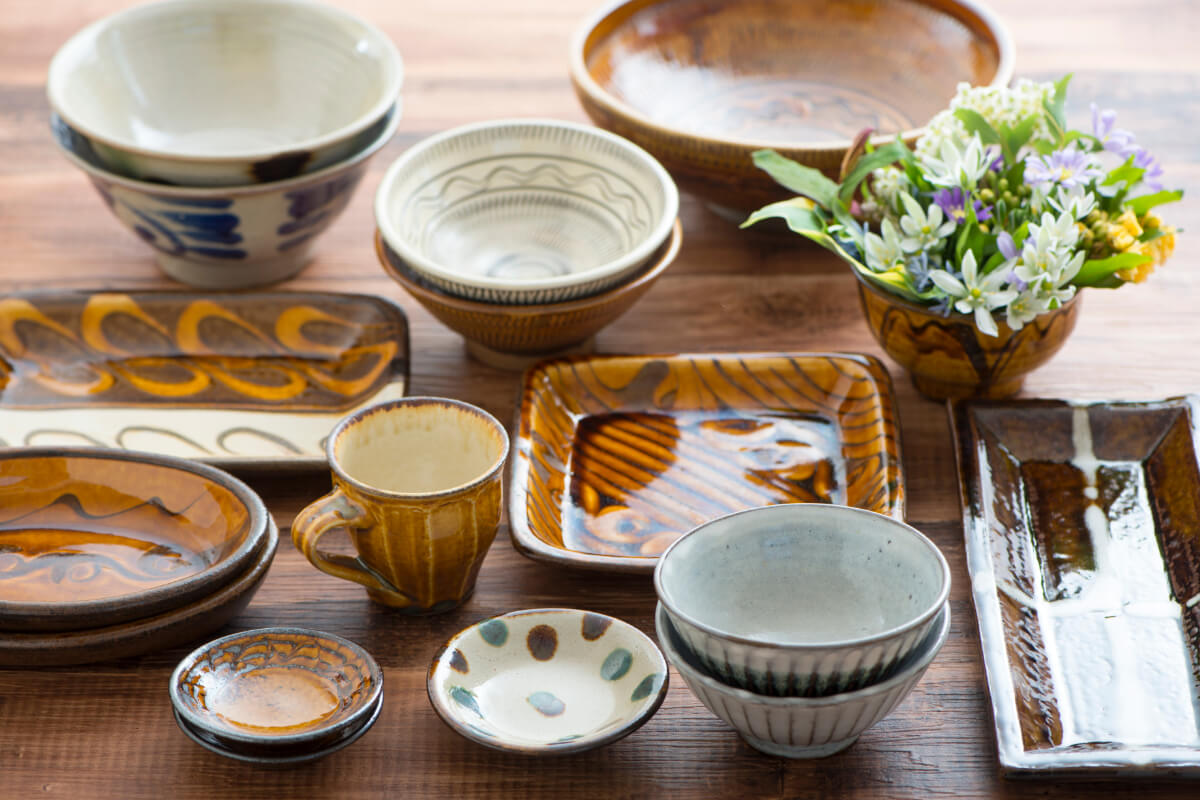
Centering on Arita, a ceramics region that sprawls across western Kyushu
Arita is a small town with a population of 15,000 that lies elongated east–west along the Aritagawa River. As befits the birthplace of Japanese porcelain and a production center with a tradition of 400 years, the town has around 150 kilns and is packed full of ceramics wholesalers and retailers, some 260 in all. Centering on Arita, the whole of western Kyushu is dense with ceramics towns. These include Imari, which was Arita’s busy shipping port in the old days (and whose name the Europeans of the time used as they pleased); Hasami, which was one of the few producers of everyday commodities (mainly tableware) in Kyushu; Yoshida, which focused its production on household goods such as bowls and pots; and Mikawauchi, whose wares were famous for their illustrations of boys or dolls dressed in Chinese clothes.
From Arita porcelain to the Imari that is familiar world-wide
In 1604, the Korean potter Ri Sanpei discovered high-quality white porcelain deposits in Izumiyama, Arita. He proceeded to build a kiln in Tengudani in Kamishirakawa, also in Arita, and started to produce porcelain. These are the origins of Arita ware. At the same time, this marks the beginning of Japan’s porcelain culture. From that time on, under the powerful protection of the Nabeshima clan, kilns producing Arita ware continued to develop as exclusive kilns for the clan, producing large quantities of high-quality works.
Potters came from all parts of Japan to learn porcelain production techniques in Arita, and porcelain wares found their way all over the country. From 1653 onwards, large amounts of Arita porcelain were exported by the Dutch East India Company to places such as Europe, where they became very popular. Copies of these exported goods were produced in towns and cities such as Meissen, Germany and Delft, Holland, and these traditions have carried on into contemporary European production today.
Arita ware is broadly categorized into three styles: the Imari style, with its sometsuke (underglaze blue) and some-nishiki (a combination of sometsuke and overglaze color painting); the Kakiemon style, with its nigoshide (milky white color) and aka-e (red painting) overglaze; and the Nabeshima style, which features iro-Nabeshima (porcelain with multi-coloured overglaze enamel). Iro-Nabeshima wares were not available to commoners—they went to the domain or were used as tribute. Meanwhile, the Imari and Kakiemon styles were sold on the general market. It was these goods that were transported across the seas and came to be known widely around the world as Imari.
The Arita brand, as popular now as it was then
The three styles of ko-Imari, Kakiemon, and Nabeshima still make up the mainstream of Arita production. Although the domain kiln that gave birth to the Nabeshima style used to lie within what is now the city limits of Arita, its traditions have carried on in the kilns that lie dotted around Okawachiyama in Imari. Production focuses on large quantities of luxury ornamental items such as vases, incense burners, and decorative dishes, and is known as Imari-yaki (Imari ware). In addition, Kakiemon and Imaemon, two large kiln that represent the traditions of Arita, each boast their own origins and special characteristics, and continue to preserve their traditions. Mikawauchi and Arita produce large quantities of ornaments and dinnerware for use in restaurants and hotels. In contrast, Hasami and Yoshida are characterized by their large volumes of general household dinnerware.

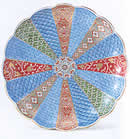
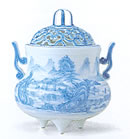
Features of each of the three styles
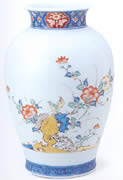 Arita ware is distinctive for its colorful and delicately painted illustrations on a white, almost transparent background surface and can be divided into three styles: ko-Imari (old Imari), aka-e (red-painting), and Nabeshima. In the early days, Arita ware was decorated with ai-sometsuke (indigo underglaze blue). Later, with the birth of the multi-colored ko-Imari style, fantastically gorgeous platters and pots came into production. The second style uses the aka-e technique, which was said to have been perfected by Sakaida Kakiemon, the first Japanese potter to succeed in the technique of colored overglaze enamelling. The beauty of the subtle harmony between Kakiemon’s characteristic technique of nigoshide, which produces a milky white ceramic base, and aka-e, with its effective use of white space, still looks fresh today, almost 400 years later. The final style, Nabeshima ware, which was produced under the protection of the Nabeshima clan, pursued elaboration, sophistication, and perfection, and was used exclusively for gifts and tribute offered by the clan. Nabeshima ware comprises ai-Nabeshima, with its underglaze blue, and iro-Nabeshima, with its overglaze painting in a color scheme of red, yellow, and green. With very few pieces still in existence, these are considered a precious part of Japan’s cultural heritage.
Arita ware is distinctive for its colorful and delicately painted illustrations on a white, almost transparent background surface and can be divided into three styles: ko-Imari (old Imari), aka-e (red-painting), and Nabeshima. In the early days, Arita ware was decorated with ai-sometsuke (indigo underglaze blue). Later, with the birth of the multi-colored ko-Imari style, fantastically gorgeous platters and pots came into production. The second style uses the aka-e technique, which was said to have been perfected by Sakaida Kakiemon, the first Japanese potter to succeed in the technique of colored overglaze enamelling. The beauty of the subtle harmony between Kakiemon’s characteristic technique of nigoshide, which produces a milky white ceramic base, and aka-e, with its effective use of white space, still looks fresh today, almost 400 years later. The final style, Nabeshima ware, which was produced under the protection of the Nabeshima clan, pursued elaboration, sophistication, and perfection, and was used exclusively for gifts and tribute offered by the clan. Nabeshima ware comprises ai-Nabeshima, with its underglaze blue, and iro-Nabeshima, with its overglaze painting in a color scheme of red, yellow, and green. With very few pieces still in existence, these are considered a precious part of Japan’s cultural heritage.
The overglaze porcelain that adorned Edo culture
Surprisingly, colored overglaze enamel painting was never attempted on the Korean Peninsula, despite it being the source of Japan’s porcelain culture. In Japan, the Kakiemon and iro-Nabeshima styles were developed concurrently with early Imari ware, which was during the early Edo period (1603–1868), through the Genroku era (1661–1688). These styles added colorful adornment to Edo-period culture. By the late Edo period, porcelain making techniques had spread from Arita to all parts of the country, with a large number of colored overglaze porcelain wares being created as a consequence. However, Imari ware remained unequalled, both in terms of the quality and quantity of production.
New input from the continent
The city of Karatsu in Saga Prefecture, northwestern Kyushu, faces the Genkai Sea, and, from ancient times, served as a busy port for trade with China and Korea on the Asian continent. The very name of the city means to “the port (tsu) that trades with China (kara),” or continental Asia in general. Karatsu ware was so well known in the past that pottery items were referred to as karatsu-mono (lit. Karatsu things) in Japan. There are many theories as to its origins. One is that Karatsu ware originated in the ancient times of the Yamato court, when Empress Jingu is said to have led a military invasion of Korea in the 3rd century. Another theory, which is based on the discovery of the remains of old kilns, is that pottery production started around the end of the Muromachi period (1338–1573) to the start of the Momoyama period (1582–1603). Yet another theory is that Karatsu ware was first produced by Korean potters who were brought back to Japan after Toyotomi Hideyoshi’s invasions of Korea in the late 16th century. While the origins of Karatsu ware remain unclear, the kick wheels and climbing kilns that were introduced by Korean potters definitely did create a major revolution in Japan’s ceramics industry. Representative examples of Karatsu ware styles include brush decorated Karatsu, Korean Karatsu, mottled Karatsu, and Mishima Karatsu. The most well known of these is brush decorated Karatsu (e-garatsu), which features an ash glaze applied over a simple floral pattern. Karatsu ware is also characterized by a unique technique known as tataki (beating), in which cylindrically stacked strings of clay are formed into a piece while the inner and outer sides are beaten. This technique was revived by 12th-generation master potter Taroemon Nakazato. Present-day Karatsu ware centers around the production of three brothers in the Nakazato family: Takashi, Shigetoshi, and primarily, the 13th-generation Taroemon Nakazato.
Karatsu Ware (Karatsu-yaki)

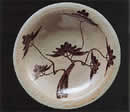
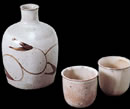
A wealth of attractions in a historic ceramics town
As is worthy of the birthplace of porcelain in Japan, the town of Arita has not only countless ancient kilns and art galleries and museums devoted to porcelain, but also many potteries offering study tours and the chance to experience hands-on pottery making or painting on fired pieces. This allows for ceramics to be enjoyed from multiple angles, including sight and touch. Walking around Arita, visitors will experience the ambience of a pottery town, with its old-style tombai walls and rows of whitewashed houses. Meanwhile, Okawachiyama in nearby Imari is another ceramics village with 30 different potteries. Surrounded by mountains in three directions, Okawachiyama is known as Hiyo no Sato (village of secret kilns). It has many pottery-related attractions including Nabeshima Hanyo Park and Potters’ Grave, and offers a different atmosphere to that found in Arita. The streets of the town still have the buildings of old-time pottery traders, reminding us of its history as a busy shipping port. In addition to all this, nearby the Arita production area are the towns of Mikawachi, the producer of the familiar karako-e (decorations with children and dolls in Chinese clothes) wares, and Yoshida and Hasami, which produced general tableware that was used all over Japan. Despite being overshadowed by Arita and Imari, these areas are also dotted with many potteries and are bustling with shoppers at times such as pottery festivals.
Arita Ceramics 400th Anniversary
In 1616, Japan’s first porcelain was born in Arita. In 2016, Arita ware reaches its 400th birthday. For this special occasion, Saga Prefecture and the town of Arita started several projects. Check the links below for the details.
- Arita Episode 2
- http://arita-episode2.jp/
- Aria Ceramics 400th Anniversary
- http://arita400.com/
Organizations
- Arita Tourism Association
- http://www.arita.jp.e.ew.hp.transer.com/
- Arita Ceramics Home Plaza
- http://www.arita.gr.jp/
- Saga Pottery Industry Co-operative Association
- http://www.aritayaki.or.jp/
